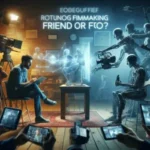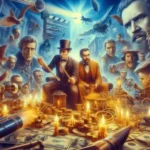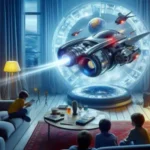In an era where cinematic storytelling is constantly evolving, the film industry finds itself at a fascinating crossroads, merging the allure of innovation with the comforting embrace of nostalgia.
As filmmakers experiment with groundbreaking technologies, immersive storytelling techniques, and fresh narratives, audiences simultaneously crave the familiar touchstones of beloved classics. This delicate balancing act presents a unique challenge: how to honor the rich legacy of cinema while embracing the new possibilities that modern filmmaking offers. From reimagined franchises to bold original works that pay homage to the past, the dynamic interplay between innovation and nostalgia shapes the viewing experience in profound ways. In this blog post, we will explore how contemporary filmmakers navigate this intricate landscape, examining the creative strategies they employ to blend the old with the new, and ultimately, how this fusion impacts our collective cinematic experience. Join us as we delve into the heart of modern cinema and uncover the magic that arises when innovation meets nostalgia.
1. Introduction: The Dual Forces of Innovation and Nostalgia
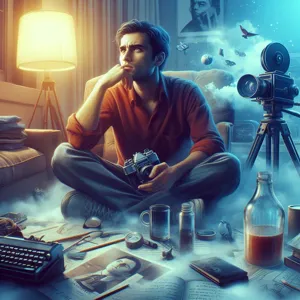
In the ever-evolving landscape of modern cinema, filmmakers are faced with a delicate balancing act between innovation and nostalgia. As audiences become increasingly discerning and diverse, the appetite for fresh narratives and groundbreaking techniques must be harmonized with the familiar comforts of beloved classics. This dynamic interplay shapes the way stories are told, inviting viewers to explore new worlds while simultaneously tugging at the heartstrings of their cherished memories.
Innovation in cinema often takes the form of cutting-edge technology—think stunning visual effects, immersive virtual reality experiences, and groundbreaking storytelling techniques that challenge traditional formats. These advancements captivate audiences and push the boundaries of what is possible in filmmaking. Directors and writers are experimenting with nonlinear narratives, interactive storytelling, and unconventional character arcs, creating a rich tapestry of cinematic experiences that reflect the complexities of contemporary life.
Conversely, nostalgia serves as a powerful emotional anchor for viewers. It evokes a sense of familiarity and comfort, drawing on the collective memories associated with iconic films, beloved characters, and timeless themes. Whether through remakes, reboots, or homage-filled storytelling, filmmakers tap into this reservoir of shared cultural experiences, inviting audiences to relive the magic of cinema’s past while introducing new generations to the classics that shaped the industry.
As we explore this intricate duality, we’ll delve into how successful films manage to weave innovation and nostalgia into their narratives, creating a cinematic experience that resonates on multiple levels. From the resurgence of retro aesthetics to the innovative twists on classic tales, we will examine the strategies that filmmakers employ to strike this crucial balance, ultimately enriching the cinematic landscape and ensuring that both the old and the new coexist harmoniously in the hearts of audiences worldwide.
2. Defining Innovation in Modern Cinema
Innovation in modern cinema is an ever-evolving concept, encompassing a spectrum of advancements that redefine storytelling, visual aesthetics, and audience engagement. At its core, innovation is about pushing the boundaries of traditional filmmaking techniques and exploring new avenues for creative expression. This can manifest in various forms, from groundbreaking technology to unique narrative structures.
One of the most significant aspects of innovation today is the use of technology. The advent of digital filmmaking tools, CGI, and virtual reality has transformed the way stories are told on screen. Directors and cinematographers now have the ability to create immersive worlds that were once relegated to the realm of imagination. Films like “Avatar” and “Blade Runner 2049” exemplify this shift, utilizing cutting-edge visual effects to enhance the storytelling experience and transport audiences to fantastical realms.
Moreover, innovation also extends to narrative techniques. Filmmakers are increasingly experimenting with non-linear storytelling, interactive formats, and multi-platform experiences that engage viewers in new ways. projects like “Bandersnatch,” a Netflix film that allows viewers to make choices that affect the storyline, highlight how innovation can create a more participatory experience, inviting audiences to become active participants in the narrative.
However, innovation in cinema is not solely about technology or narrative experimentation; it also encompasses fresh approaches to representation and inclusivity. Modern filmmakers are breaking away from traditional casting and storytelling norms to amplify diverse voices and perspectives. This shift is not only vital for reflecting the world we live in but also enriches the cinematic landscape, offering audiences a wider array of stories to connect with.
In navigating innovation, filmmakers must remain aware of the delicate balance between embracing new ideas and honoring the art form’s rich history. The challenge lies in forging a path that respects the foundational elements of cinema while daring to explore the uncharted territories of creativity. As we witness this dynamic interplay between innovation and nostalgia in modern cinema, it becomes clear that the future of film is not just about what is new, but also about how the new can coexist with the beloved traditions of storytelling that have captivated audiences for generations.
3. The Role of Nostalgia in Film Storytelling
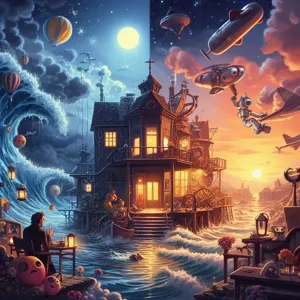
Nostalgia has become an integral thread in the fabric of modern cinema, weaving together the rich tapestry of past experiences with contemporary storytelling. It evokes a powerful emotional response from audiences, tapping into cherished memories and familiar cultural references. Filmmakers are increasingly leveraging this sentiment to create films that resonate on a deeper level, allowing viewers to relive the joys and complexities of their youth. Whether it’s a reimagining of a beloved classic or a sequel that revisits the characters we once adored, nostalgia can serve as a bridge that connects generations.
In this digital age, where rapidly changing technology can make the present feel fleeting, films that evoke nostalgia provide a comforting sense of familiarity. For instance, many directors skillfully incorporate iconic music, fashion, and visual styles from previous decades, creating an immersive experience that transports audiences back in time. Think of the striking cinematography and soundtracks that bring to life the essence of the ‘80s or the ‘90s, instantly resonating with viewers who grew up during those eras.
Moreover, nostalgia acts as a storytelling device that enriches character development and plotlines. By placing characters in familiar settings or situations, filmmakers can explore themes of memory, loss, and the passage of time, allowing audiences to reflect on their own lives. A film might depict a protagonist returning to their childhood home, igniting a series of flashbacks that reveal pivotal moments in their journey. This interplay between past and present not only deepens the narrative but also fosters a sense of shared experience among viewers, who may find echoes of their own stories within the film.
However, it’s important for filmmakers to strike a balance. While nostalgia can enhance a story, over-reliance on it may lead to a lack of originality and innovation. Audiences crave fresh perspectives and new stories, so filmmakers must blend nostalgic elements with original ideas to avoid becoming trapped in a cycle of repetition. By thoughtfully integrating nostalgic references in ways that complement and elevate the narrative, filmmakers can craft compelling stories that honor the past while boldly forging new paths in cinema.
In this delicate balancing act, nostalgia becomes not just a tool for storytelling, but a powerful means of connecting with audiences. It reminds us of who we are, where we’ve been, and the stories that shape us, all while inviting us to embrace the unknown adventures that lie ahead.
4. Historical Context: How Nostalgia Shaped Early Cinema
Nostalgia has long been a powerful force in cinema, shaping the stories we tell and the way we tell them. In the early days of film, the medium was often used as a vehicle for collective memory, evoking a sense of shared history that audiences could connect with. From the silent films of the early 20th century to the golden age of Hollywood, filmmakers tapped into the cultural zeitgeist, crafting narratives that resonated with audiences who were longing for a connection to their past.
Consider the emergence of the Western genre, for example. Films like “The Great Train Robbery” (1903) not only entertained but also served as a reflection of America’s frontier spirit, evoking a sense of nostalgia for a simpler time. These stories romanticized the past, often glossing over the harsher realities of history, and in doing so, they created a mythos that audiences could both escape into and find comfort in. The portrayal of rugged individualism and the triumph of good over evil appealed to the collective psyche, allowing viewers to relive a version of history that aligned with their ideals.
As cinema evolved, so too did the ways in which nostalgia was utilized. The rise of musicals in the 1950s, for example, brought a vibrant celebration of bygone eras, drawing inspiration from the glamour and optimism of earlier decades. Films like “Singin’ in the Rain” not only showcased the joy of performance but also harkened back to the golden age of Hollywood, reminding audiences of the magic that first drew them to the silver screen. This interplay between innovation and nostalgia became a hallmark of cinema, inviting filmmakers to experiment with new techniques while simultaneously paying homage to the past.
Moreover, the influence of historical context on filmmaking cannot be understated. During times of societal upheaval or change, filmmakers have often turned to nostalgia as a means of escape or reflection. The post-war era, for instance, saw a resurgence of classic themes and styles, as audiences sought comfort in familiar narratives amidst the uncertainty of the times. In this way, nostalgia served not only as a stylistic choice but also as a coping mechanism for viewers grappling with the complexities of modern life.
As we navigate the landscape of contemporary cinema, it’s essential to recognize how the historical context of early films has laid the groundwork for the ongoing dance between innovation and nostalgia. By understanding this relationship, we can better appreciate the films of today and the intricate ways they continue to reflect, challenge, and celebrate our collective memory. Whether through remakes of beloved classics or original stories that echo familiar themes, the legacy of nostalgia remains a potent force in shaping the narratives that captivate our hearts and minds.
5. Case Studies: Successful Films Blending Innovation and Nostalgia
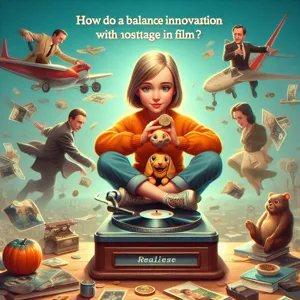
In the ever-evolving landscape of modern cinema, the delicate balance between innovation and nostalgia has proven to be a winning formula for many filmmakers. By drawing on beloved elements from the past while infusing fresh ideas and techniques, these films not only resonate with audiences but also set new benchmarks for creativity. Here, we delve into some notable case studies that exemplify this successful blend.
**1. *Stranger Things***
This hit Netflix series epitomizes the art of nostalgia, drawing heavily from the aesthetics and storytelling tropes of the 1980s. From the synth-heavy soundtrack to the iconic fashion choices, *Stranger Things* embraces its retro influences wholeheartedly. However, it takes innovation a step further by weaving in supernatural elements and complex character arcs that keep viewers engaged. The show’s ability to evoke fond memories while presenting a modern narrative has garnered a dedicated fanbase spanning multiple generations.
**2. *Star Wars: The Force Awakens***
When Disney revived the *Star Wars* franchise with *The Force Awakens*, it faced the monumental task of honoring the legacy of the original trilogy while appealing to a new generation. The film successfully integrated familiar characters, themes, and visual styles, rekindling the nostalgia of longtime fans. At the same time, it introduced new characters like Rey and Finn, who brought fresh perspectives and stories into the mix. This balance not only reignited passion for the saga but also expanded its universe, making it relevant for contemporary audiences.
**3. *Coco***
Pixar’s *Coco* is a vibrant celebration of Mexican culture and the Day of the Dead, seamlessly blending innovative animation techniques with timeless themes of family and remembrance. While the film incorporates traditional elements and folklore, it does so in a way that feels fresh and engaging. The stunning visuals and emotional storytelling resonate with viewers, making it a modern classic that honors cultural heritage while pushing the boundaries of animated filmmaking.
**4. *The Lego Movie***
This film reinvigorated the Lego brand by combining playful nostalgia with innovative storytelling techniques. Drawing on a shared cultural memory of Lego as a childhood toy, it presents a narrative that is both whimsical and thought-provoking. The unique animation style and clever humor appeal to both children and adults, allowing for a multi-generational experience while cleverly leveraging the nostalgia associated with building blocks.
In conclusion, these case studies illustrate that the integration of innovation and nostalgia in cinema is not only possible but can lead to remarkable success. By honoring the past while daring to explore new storytelling avenues, filmmakers can create works that resonate deeply with audiences, ensuring that they remain relevant and beloved for years to come.
6. The Impact of Technology on Filmmaking
The impact of technology on filmmaking has been nothing short of revolutionary, reshaping every aspect of the cinematic experience. From the tools used in production to the ways audiences consume content, technology continues to push the boundaries of what is possible in film. With the advent of high-definition cameras, drone cinematography, and sophisticated editing software, filmmakers now have unprecedented creative freedom, allowing them to produce visually stunning narratives that were once confined to the realms of imagination.
In addition to enhancing visual aesthetics, technology has also democratized filmmaking. The rise of affordable equipment and software has empowered aspiring filmmakers to bring their stories to life without the need for a Hollywood budget. Independent films, often driven by unique visions, have gained traction in the industry, breathing fresh air into traditional storytelling. This shift has led to a more diverse array of voices and perspectives, enriching the cinematic landscape.
However, the integration of technology doesn’t come without its challenges. As filmmakers embrace new advancements—like virtual reality (VR) and augmented reality (AR)—they must navigate the delicate balance between innovation and the essence of storytelling. While these technologies offer immersive experiences, they can sometimes overshadow the narrative, leading to a spectacle that prioritizes gimmickry over genuine emotional connection. Audiences may find themselves captivated by the allure of high-tech effects but yearning for the heartfelt storytelling and character development that have defined great cinema throughout history.
Moreover, the rapid evolution of streaming platforms has transformed how we consume films, creating a trend towards shorter content and binge-watching culture. While this accessibility brings films to a broader audience, it also raises questions about the value of the cinematic experience. Will the future of film be defined by quick, digestible content, or can it still find room for the deep, immersive stories that linger long after the credits roll?
As we navigate this complex landscape of innovation and nostalgia, filmmakers must remain mindful of their audiences—balancing cutting-edge technology with the timeless art of storytelling. In doing so, they can create films that not only dazzle the eye but also resonate with the heart, ensuring that both innovation and nostalgia coexist harmoniously in modern cinema.
7. Audience Expectations: Why Nostalgia Resonates
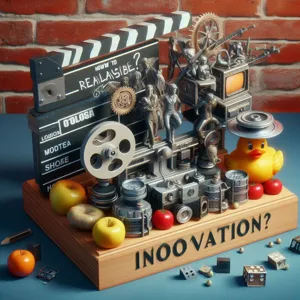
In today’s cinematic landscape, audiences are more discerning than ever, often seeking a delicate balance between innovation and nostalgia. The power of nostalgia lies in its ability to evoke emotional connections and shared experiences. When viewers encounter familiar characters, iconic soundtracks, or beloved story arcs, it triggers a wave of memories and feelings, transporting them back to a time when life felt simpler or more exciting. This emotional resonance is why nostalgia has become a potent tool for filmmakers aiming to capture audience attention.
Nostalgia resonates because it taps into the collective consciousness of generations. Take, for instance, the resurgence of classic franchises like *Star Wars* or *Ghostbusters*. These films not only attract longtime fans who yearn for a return to their youth but also introduce new viewers to the magic of these beloved stories. The blending of old and new creates a bridge across generations, fostering a sense of community among fans. This phenomenon is not limited to sequels and remakes; it extends to original works that cleverly reference or pay homage to past cinematic triumphs.
Moreover, audience expectations have shifted. Viewers are no longer just passive consumers; they actively seek content that resonates with their personal histories. This desire for familiarity often compels filmmakers to infuse nostalgic elements into their narratives, whether through visual callbacks, thematic echoes, or character reboots. However, this reliance on nostalgia must be balanced with innovation to prevent stagnation. Audiences crave fresh perspectives and original storytelling, so filmmakers must tread carefully, ensuring that nostalgia enhances rather than overshadows the new ideas they bring to the table.
In essence, understanding why nostalgia resonates with audiences is crucial for filmmakers navigating this balancing act. While it may serve as a powerful draw, it’s the seamless integration of innovative storytelling and cherished memories that ultimately captivates viewers, ensuring that they not only return to theaters but also keep the conversation alive long after the credits roll.
8. The Risks of Over-Reliance on Nostalgia
Nostalgia can be a powerful tool in modern cinema, evoking warm memories and a sense of comfort that can draw audiences back to the theaters. However, the risks of over-reliance on nostalgia are becoming increasingly apparent, as filmmakers grapple with the fine line between homage and repetition. While resurrecting beloved characters and storylines might offer a safe bet at the box office, it can also lead to creative stagnation and audience fatigue.
When studios lean too heavily on familiar franchises, they may inadvertently stifle innovation and originality. Viewers may find themselves yearning for fresh narratives and unique perspectives, rather than recycled plots wrapped in a nostalgic bow. This can create a paradox where the very thing that brings audiences in—nostalgia—can also alienate them if the content lacks depth or originality.
Moreover, the danger of nostalgia lies in its ephemeral nature. The warm glow of fond memories can quickly fade if the new interpretations fail to resonate or, worse, tarnish the legacy of the originals. Iconic films that have been lovingly preserved in the collective memory can suffer from the weight of expectation. When a long-awaited sequel or reboot doesn’t live up to the beloved original, it can lead to disappointment, backlash, and even tarnished reputations for all involved.
In this delicate balancing act, filmmakers must navigate the treacherous waters of nostalgia with caution. A successful film pays tribute to the past while forging a new path forward, blending the old with the new in a way that feels authentic and engaging. By embracing innovation alongside nostalgia, filmmakers can create a cinematic experience that honors the past while pushing the boundaries of storytelling, ultimately enriching the film landscape for both new audiences and lifelong fans alike.
9. Balancing New Ideas with Established Tropes
In the ever-evolving landscape of modern cinema, filmmakers face a fascinating yet challenging task: balancing fresh, innovative ideas with the beloved tropes that have shaped storytelling over decades. Established tropes, from the classic hero’s journey to the heartwarming romantic comedy formula, provide a familiar framework that audiences recognize and often crave. However, in an age where creativity and originality are valued more than ever, relying solely on these conventions can lead to predictability and viewer disengagement.
To strike this balance, filmmakers can draw inspiration from the past while infusing new perspectives and narratives. For instance, a contemporary twist on a well-known trope can add depth and relevance, allowing audiences to connect with familiar elements in unexpected ways. Consider a reimagining of the traditional love story, where the protagonists navigate not only romantic challenges but also the complexities of modern relationships in a digital age. By intertwining timeless themes with current societal issues, filmmakers can create a rich tapestry that resonates with both nostalgic viewers and newcomers alike.
Moreover, the visual language of cinema is ripe for innovation. Directors can experiment with cinematography, editing styles, and sound design to breathe new life into established genres. A horror film that employs unconventional storytelling techniques or a sci-fi epic that explores ethical dilemmas in a relatable context can captivate audiences and challenge their expectations. By balancing new ideas with established tropes, filmmakers can honor the cinematic heritage while pushing the boundaries of storytelling.
Ultimately, the key lies in understanding the audience’s emotional journey. By acknowledging what worked in the past and blending it with contemporary themes and unique narratives, filmmakers can create films that feel both timeless and fresh. This delicate balancing act not only preserves the magic of cinema but also paves the way for innovative storytelling that captures the hearts and minds of viewers across generations.
10. Filmmaker Perspectives: Insights from Industry Leaders
As the landscape of cinema continues to evolve, the voices of industry leaders have never been more crucial in shaping the dialogue around innovation and nostalgia. Filmmakers, producers, and screenwriters are navigating this delicate balancing act, often drawing from their own experiences and creative visions to illuminate the path forward.
Take, for instance, the insights of celebrated director Ava DuVernay, who emphasizes the importance of storytelling rooted in both personal and collective histories. DuVernay champions new narratives that pay homage to the past while also pushing the boundaries of representation and diversity. Her perspective encourages emerging filmmakers to honor their roots while forging new paths that resonate with contemporary audiences.
Similarly, veteran filmmaker Martin Scorsese offers a contrasting viewpoint. Known for his deep appreciation of classic cinema, Scorsese advocates for the preservation of film history even as technological advancements transform the medium. His recent ventures into streaming platforms illustrate how filmmakers can embrace new formats while remaining anchored in the storytelling techniques that have defined their careers. Scorsese’s reflections remind us that nostalgia can serve as a powerful tool in evoking emotions and creating connections, but it must be wielded thoughtfully in the face of rapid change.
Then there’s the innovative spirit of Greta Gerwig, whose films like *Lady Bird* and *Little Women* merge modern themes with timeless narratives. Gerwig’s work exemplifies how a fresh perspective can breathe new life into well-loved stories, making them relevant for a new generation. She believes that the key to successful filmmaking lies in understanding what resonates with audiences today while paying tribute to the influences of the past.
These filmmakers and many others are not just creating films; they are shaping the future of cinema by engaging in conversations that celebrate both innovation and nostalgia. Their insights reflect a broader trend within the industry: a recognition that the past can inform the present, and that the stories we tell today will pave the way for future generations. As we continue to explore this balance, the perspectives of these industry leaders will undoubtedly guide us in navigating the intricate tapestry of modern cinema.
11. The Future of Cinema: Trends in Innovation and Nostalgia
As we look towards the future of cinema, a fascinating interplay between innovation and nostalgia emerges, shaping the way stories are told and experienced on screen. Filmmakers are increasingly harnessing cutting-edge technology—think virtual reality, artificial intelligence, and immersive sound design—to create experiences that transport audiences to new realms. Yet, at the same time, there’s a palpable yearning for the familiar, a desire to revisit beloved classics and cherished tropes that evoke a sense of comfort and connection.
One of the most striking trends is the resurgence of retro aesthetics, with films incorporating vintage styles and techniques that harken back to earlier eras. This nod to the past is not merely a gimmick; it serves as a tribute to the cinematic legacy that has laid the groundwork for today’s storytelling. Projects like the recent adaptations of beloved franchises or the revival of classic genres, such as slasher films and romantic comedies, showcase how filmmakers are using nostalgia as a powerful tool to captivate audiences while pushing creative boundaries.
Simultaneously, there is an increasing focus on diversity and inclusivity in storytelling, which brings forth fresh narratives and perspectives that were previously underrepresented. This innovative approach is not only reshaping the narratives being told but also appealing to a broader audience that craves authenticity and relatability in cinema.
The challenge for filmmakers lies in striking the right balance—leveraging the allure of nostalgia to draw in audiences while embracing innovation to craft unique, memorable experiences. As we venture further into this new era of filmmaking, it’s clear that the future of cinema will be defined by a harmonious blend of the old and the new, where traditional storytelling techniques coexist with groundbreaking innovations, ultimately enriching the cinematic landscape for audiences of all ages.
12. How Streaming Services Influence Film Dynamics
In the ever-evolving landscape of modern cinema, streaming services have emerged as dynamic players, reshaping the way films are produced, distributed, and consumed. Unlike traditional models that relied heavily on box office performance, streaming platforms offer a unique environment where innovation and nostalgia can coexist, often influencing film dynamics in profound ways.
First and foremost, streaming services have democratized access to a diverse range of films, allowing audiences to explore both groundbreaking new releases and beloved classics with unprecedented ease. This multitude of options creates an intriguing dynamic: viewers can seamlessly transition from a fresh, avant-garde indie film to a nostalgic blockbuster from decades past. As a result, filmmakers are encouraged to push boundaries and experiment with storytelling techniques, knowing that there is an audience eager to engage with innovative content.
Moreover, streaming platforms have recognized the power of nostalgia as a marketing tool. By reviving beloved franchises or remaking classic films, they tap into the emotional connection that audiences have with these stories. This not only attracts viewers who are eager to relive their favorite cinematic moments but also introduces these narratives to a new generation. The blend of familiar characters and modern storytelling techniques allows filmmakers to innovate while still paying homage to the past, creating a unique viewing experience that resonates with diverse audiences.
Additionally, the algorithm-driven nature of streaming services allows for personalized recommendations, meaning that films blending innovation with nostalgia can be strategically promoted to the right viewers. For instance, someone who enjoyed a recent sci-fi hit might find themselves recommended a classic from the genre, encouraging a dialogue between the old and the new. This interplay not only boosts viewership but also enriches the cinematic landscape, as audiences develop a deeper appreciation for the evolution of storytelling.
Ultimately, the influence of streaming services on film dynamics is a delicate balancing act. They empower filmmakers to take risks and explore uncharted narratives while simultaneously leveraging the comfort and familiarity of nostalgia. As we continue to witness the rise of these platforms, it will be fascinating to see how they shape the future of cinema, creating a vibrant tapestry where innovation and nostalgia not only coexist but thrive together.
13. The Role of Festivals in Showcasing New Narratives
Film festivals have long served as pivotal platforms for innovation in cinema, showcasing not only the latest artistic trends but also the evolving narratives that resonate with contemporary audiences. In an era where filmmakers are increasingly blending nostalgia with fresh storytelling techniques, festivals play a crucial role in highlighting these unique voices and perspectives.
These events provide a curated space where emerging talents can present their work alongside seasoned filmmakers, creating a vibrant tapestry of storytelling that reflects the diverse experiences of the modern world. Festivals like Sundance, Cannes, and Toronto International Film Festival are celebrated not just for their star-studded premieres but for their dedication to unearthing groundbreaking narratives that challenge conventional norms. Here, directors can take creative risks, often merging familiar themes from the past with innovative approaches to storytelling, inviting audiences to reflect on how history informs our present.
Moreover, festivals foster community by bringing together filmmakers, critics, and audiences in an environment that encourages dialogue and exploration of new ideas. Panel discussions, Q&A sessions, and workshops offer invaluable insights into the creative process, showcasing how nostalgia can be reinterpreted to craft relevant and resonant tales for today’s viewers. This is particularly important as audiences increasingly seek authenticity and connection in the stories they consume.
As cinematic landscapes shift and evolve, festivals will continue to be instrumental in showcasing new narratives that strike a balance between honoring the past and embracing the future. They remind us that while we may cherish the familiar, it is the innovative spirit of cinema that pushes boundaries and opens our minds to new possibilities. By spotlighting films that weave together threads of nostalgia and innovation, festivals not only celebrate the art of storytelling but also shape the future of cinema itself.
14. Conclusion: Finding Harmony in Film Innovation and Nostalgia
In the ever-evolving landscape of modern cinema, the interplay between innovation and nostalgia presents a unique balancing act for filmmakers and audiences alike. As we draw this exploration to a close, it’s clear that both elements are not only essential but can coexist harmoniously to create compelling narratives that resonate with a diverse audience.
Innovation breathes new life into storytelling, pushing the boundaries of technology and creativity. From groundbreaking visual effects that transport viewers into fantastical realms to experimental filming techniques that challenge conventional narratives, the allure of novelty captivates a generation eager for fresh experiences. At the same time, nostalgia serves as a powerful connective tissue, evoking memories and emotions tied to our past. It taps into a shared cultural heritage, reminding us of stories that shaped our identities and the films that accompanied significant moments in our lives.
The key lies in striking a balance; filmmakers who honor the classics while embracing new ideas are often the most successful. By weaving modern sensibilities into familiar themes, they can create a cinematic experience that feels both innovative and deeply relatable. This delicate dance not only enriches the viewing experience but also invites a broader audience to engage with film in meaningful ways.
As we move forward, it is crucial for creators to listen to the pulse of their audience, recognizing that while the landscape may shift, the desire for connection through storytelling remains constant. By finding harmony between innovation and nostalgia, filmmakers can craft narratives that not only entertain but also inspire, ensuring that the magic of cinema continues to thrive in the hearts of viewers for generations to come.
15. Call to Action: Encouraging Diverse Storytelling in Cinema
As we reach the end of our exploration into the intricate dance between innovation and nostalgia in modern cinema, it’s imperative to embrace a call to action that champions diverse storytelling. The cinematic landscape is richer and more vibrant when it reflects a multitude of voices, experiences, and perspectives. As audiences, we have the power to advocate for the stories that resonate with us and those that challenge the status quo.
Encouraging diverse storytelling means supporting films that showcase underrepresented narratives, whether it’s through the lens of different cultures, gender identities, or socioeconomic backgrounds. It’s about actively seeking out and celebrating filmmakers who push boundaries and bring fresh ideas to the table, rather than relying solely on familiar tropes or reboots of beloved classics.
Moreover, as viewers, we can engage in conversations about the films we watch. Sharing our experiences and insights on social media, writing reviews, and participating in community discussions can amplify the voices of those telling diverse stories. By choosing to support independent films and attending festivals that highlight new talent, we can help cultivate an environment where innovative narratives flourish alongside the nostalgia that many hold dear.
Let’s not forget the power of our wallets—streaming services, box office sales, and merchandise purchases can directly influence what projects get greenlit. By championing films that prioritize diverse storytelling, we send a clear message to studios and creators: There is a demand for more than just the familiar; there is a hunger for authenticity and representation.
In this new era of cinema, let’s advocate for a balanced approach that respects the past while boldly stepping into the future. Together, we can encourage a cinematic landscape that is not only reflective of our world but also inspires future generations of storytellers to dream bigger and bolder. Embrace the call to action and be a part of this transformative journey in cinema!
As we conclude our exploration of the delicate balancing act between innovation and nostalgia in modern cinema, it’s clear that filmmakers are continuously walking a tightrope, striving to capture the hearts of both new audiences and devoted fans of classic films. The fusion of cutting-edge storytelling techniques with beloved elements from the past not only enriches the cinematic experience but also fosters a deeper connection to our collective cultural memory. As viewers, we are invited to embrace this dynamic interplay, celebrating the creativity that arises from honoring tradition while daring to forge new paths. We hope this discussion has sparked your curiosity to seek out films that embody this balance and inspired you to reflect on how these themes resonate with your own viewing experiences. So, the next time you settle in for a movie night, consider the innovative twists that breathe new life into nostalgic favorites, and enjoy the magic that unfolds on screen.



